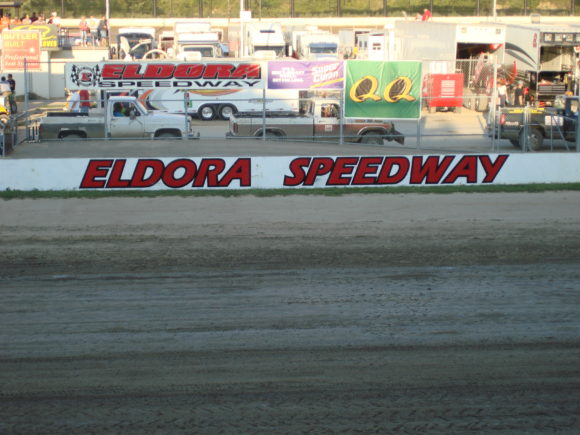Most professional sports that have multiple entrants in the same event have their marquee events that every participant would love to win. Typically some combination of prize money, prestige, and the venue at which the event plays out factor into whether or not the contest can be labelled as a crown jewel of that particular sport or not.
Golf and tennis each have their four major tournaments that stand above the rest. Horse racing has its Triple Crown. NASCAR has races such as the Daytona 500, the Southern 500, and this weekend’s Coca-Cola 600 that are on every driver and car owner’s must win lists. And the Indianapolis 500 towers above all other events in the IndyCar form of auto racing.
With the Show-me 100 set to be contested at Missouri’s Lucas Oil Speedway on Saturday night, the age old discussion of what constitutes a Dirt Late Model crown jewel race has renewed on message boards and social media. That being the case, I thought I would take this opportunity to weigh in on the subject with my opinion as well.
I will be the first to admit that my knowledge of the history of Dirt Late Model racing is not as extensive as many others since I was away from this type of racing for a number of years before renewing my interest somewhere around 2008. That said, I have watched a lot of laps being logged since then and feel as if I have a pretty good grasp of the current situation in the sport.
I don’t know that there is necessarily a set number of races that can be considered crown jewels, but as mentioned above, most sports have three or four contests that are held above the rest. Dirt Late Model fans are mixed on this as some may list five, six or more races they consider to be the cream of the crop while others may only have two or three.
All of that said, I have come up with a set of criteria for determining whether or not a race can be considered a crown jewel. While each race may not necessarily have to meet every one of these criteria, it would be essential to meet most of them.
Purse: For a race to be thought of as a top tier event, it has to pay the winner a significant amount. In a recent poll I ran on Twitter to gauge the fans’ view on this topic, there was a very close vote between the amounts of $20,000, $25,000 and $30,000 as the minimum payout to the winner of the race for it to be considered a crown jewel.
In my opinion, a race should pay the winner no less than $25,000 if it is to earn the title of a crown jewel. This, to me, is an absolute requirement for such recognition. While $20,000-to-win races are certainly noteworthy in the grand scheme of things, they are not crown jewel worthy.
On the other side of that, I would consider any race that pays $50,000 or more as a “no-brainer” crown jewel race. Any promoter who is willing to put that much cash on the line deserves to have his/her race placed on the list. Besides, there are so few of those races that such a reward to the winner clearly offsets any lack of tradition or a miss in any of the other criteria that I am about to lay out.
Tradition: Although I don’t know this for a fact, I believe most golfers would play in The Masters at the Augusta National Country Club even if it didn’t pay any prize money at all. The tradition of the event is so overwhelming that the ability to claim the championship is more important than the check that is deposited in the bank.
Granted, Dirt Late Model racers can’t operate under those same conditions. There is so much money invested in the cars, haulers, crew members, etc… that there has to be some return on that investment for a team to compete. That’s why I listed purse money as the first of my criteria and stated that there is a minimum amount that I would consider to be crown jewel worthy.
However, the history of the event can be so great that the prize money may not have as much bearing as the prestige in the minds of the competitors. A race such as the World 100 would almost certainly fit this description. Ask any driver who has had the good fortune to win one and they will count that race’s iconic globe trophy among their most prized possessions.
But unlike prize money, I do not consider a long history to be essential in declaring a race as a crown jewel. If that were the case, there would be no real chance for any new crown jewels to arise. Two relatively new entries into the crown jewel discussion, the Prairie Dirt Classic at the Fairbury American Legion Speedway in Illinois and the Silver Dollar Nationals at Nebraska’s I-80 Speedway, are examples of events that have not necessarily been in the national spotlight for decades but they have achieved other pieces of the criteria I am laying out here.
The bottom line is that tradition does indeed matter and can go a long way toward determining a race’s crown jewel status, but it is not an end-all, be-all factor, in my opinion.
Venue: What role does the site in which the event is contested play in determining whether a race is a crown jewel or not? Refer back to the example provided above of tennis having four of its tournaments considered as majors. The All England Club in Wimbledon is thought of as a mecca of sorts for that sport. The same can be said for the Indianapolis Motor Speedway for the IndyCar form of racing and the Darlington Raceway in NASCAR. In these cases, the venue contributes significantly to the stature of the event.
Dirt racing has at least a couple of these highly prized locations. The Eldora Speedway in Ohio is certainly a place that would appear on the ‘bucket list’ of just about every fan or competitor in this sport. Many would go out of their way just to stop by and look inside the gates of the track even on a day in which no race is being contested there. It has a sort of Wrigley Field or Fenway Park type of feel to it according to many who have been there.
Although Iowa’s Knoxville Raceway is more known for Sprint Car racing than for Dirt Late Models, it has quickly grown into one of those mecca type places to race for the full bodied cars on clay. Several drivers rank the Dirt Late Model Knoxville Nationals as one of their most coveted races and the venue almost certainly plays a role in that.
And while having an old, traditional feel to a place can certainly add to the mystique of an event, having a newer and more modern venue can also be desirable. Many argue that the Show-me 100 has lost some of its appeal since the move from its traditional West Plains Speedway home. At the same time, the Lucas Oil Speedway, where the race is now run, is among the most up-to-date racing facilities in any form of motorsports. Both traditional and modern have their merits, but any crown jewel race should have one or the other. Crown jewels are not meant for mediocre venues.
Ability to draw a quality field: It seems obvious to say that if a race meets my criteria for purse money, it will draw a quality field. But how many drivers who typically race under one national series sanctioning banner crossover to compete if the race is conducted by the other series? And for that matter, how much does sanctioning by one or the other series even matter?
This is one area in which the Lucas Oil sanctioned Show-me 100 suffers due to the fact that the World of Outlaws Late Models has races scheduled for this Memorial Day weekend that will prevent those racers from travelling to Wheatland, MO for that race.
In my opinion, for a race to be thought of as a crown jewel there should be no fewer than 15-20 racers in a given pit area who could potentially be thought of as a contender for the win. Last year’s Dirt Late Model Dream provides an example as very few would have listed Dennis Erb, Jr. among their top three or four favorites going into the race, but at the end of the night, he walked away with the $100,000 victory and few were completely shocked by that outcome.
But consider that races such as those conducted during the Georgia-Florida Speedweeks portion of the racing schedule often draw crown jewel type fields. However, those races do not pay enough to meet the minimum criteria. The same could be said for the World Finals held each year at The Dirt Track in Charlotte. Those are great events to attend, but they are not crown jewel caliber because of the purses offered, in my opinion.
For a race to be one of the sport’s top tier events, it has to have a quality field every year. But like tradition mentioned above, it is not the end-all, be-all as other factors must also be considered.
Popularity of the event: Just because a particular race is popular does not mean it fits into the category of a crown jewel. But like some of the other factors listed above, it can help the cause of a race to fit into this category.
A great example of this is the Prairie Dirt Classic at the Fairbury American Legion Speedway. That race does pay a good purse and it does draw an excellent field of cars to what appears to be an awesome venue. But more, the race has become wildly popular among fans and drivers alike over the past few years. So much so that regional drivers who might never consider pulling their cars to Illinois for a race just because of the payout do so simply to be a part of the excitement.
So a race being popular certainly helps raise its status among other similar type events.
There it is. This is my list of criteria for a race being known as a crown jewel event. As I stated above, purse money is a definite must to fit into this glorified grouping. At the same time, a race must fall into the two or three of the other requirements to fully make the grade.
Your list of criteria may very well be different from mine, but that is what makes the discussion of the sport we all love fun.







